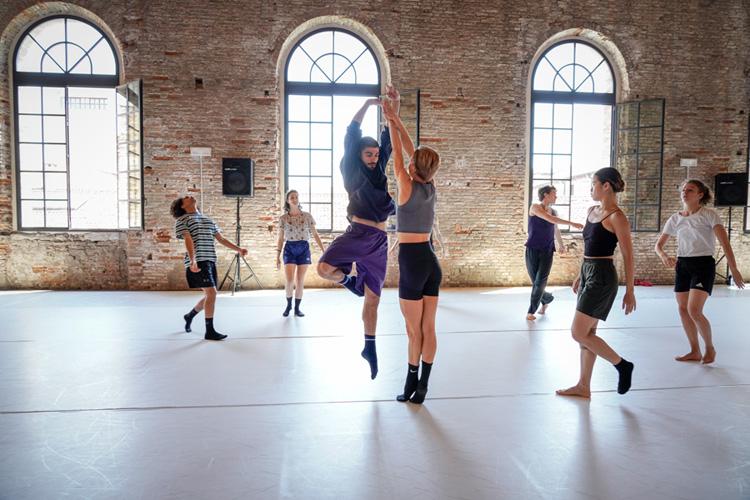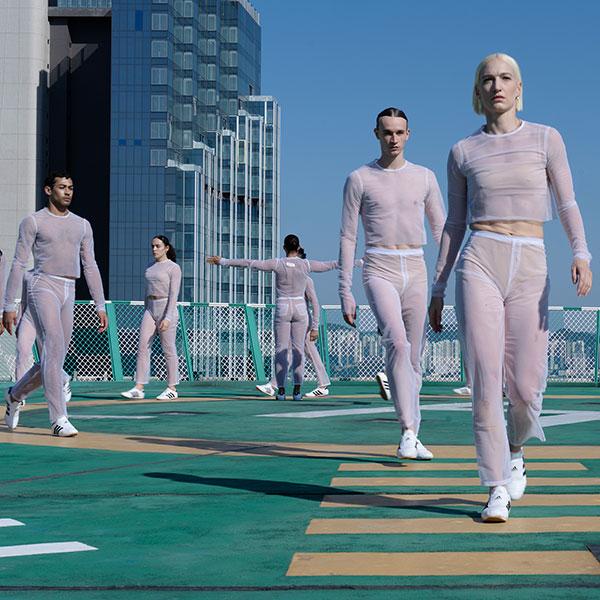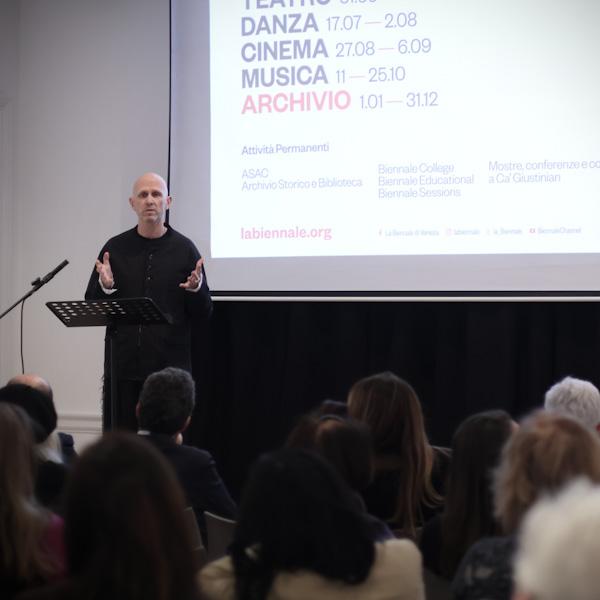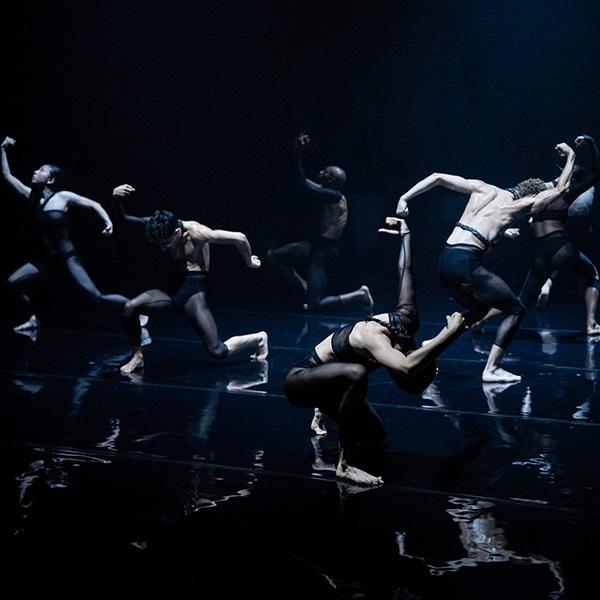
Biennale Danza 2021: over 100 artists into Wayne McGregor’s directorship
From 23 July to 1 August, the Festival features live performances with choreographers and companies from around the world, the new energy of the Biennale College, and the commissions for new dance.
Biennale Danza 2021
First Sense
Everything that can be done with dance and through dance today. In his first year as the director of the 15th International Festival of Contemporary Dance (23 July > 1 August), Wayne McGregor illuminates the complexity, the breadth, the “transformability” of a discipline that thrives on renewal and which, in its dialogue with the most cutting-edge thinking, advances the development of contemporary art.
The map of the Biennale Danza 2021 is divided into seven steps/acts: the live performances with choreographers and companies from around the world, the multilingual installations, the new energy of the Biennale College, the rich production of films about and featuring dance, the collaborations among the disciplines within La Biennale itself, the conversations with the artists and the commissions for new dance. 10 days of events with over 100 artists, all Italian premieres, two World premieres and one European premiere.
Live
Josef Nadj with eight dancers coming from different African countries; Hervé Koubi, the French-Algerian choreographer with his multi-ethnic company and the Jewish-Egyptian vocalist Natacha Atlas; Marco D’Agostin from Italy; Americans Pam Tanowitz – dancer and choreographer - and Simone Dinnerstein, pianist, accompanied by Pam Tanowitz Dance; Olivier de Sagazan, the French artist from Brazaville; the Basque dancer Iratxe Ansa who with Igor Bacovich from Italy form Metamorphosis, based in Madrid; Rone, a champion of the French electronic scene, with the artistic collective (La)Horde: Marine Brutti, Jonathan Debrouwer and Arthur Harel, who has been the head of the Ballet national de Marseille for a year; Oona Doherty from Northern Ireland and Germaine Acogny from Senegal. These are the artists of a live performance scene that has no borders, resonant with the forms and content of the world. Radicals, as McGregor defines them, the expression of an incisive dance that, compelled by the urgencies of the world, speaks to our time.
Djino Alolo Sabin, Timothè Ballo, Abdel Kader Diop, Aïpeur Foundou, Bi Jean Ronsard Irié, Jean-Paul Mehansio, Marius Sawadogo, and Boukson Séré – from Congo, Ivory Coast, Senegal, Mali, and Burkina Faso – are the eight dancers that, strong of the richness of their different backgrounds, – spanning from traditional dances, wrestling, rap, ballet and acrobatics – give Josef Nadj’s “movement theatre” new limph. Everything is a source of inspiration for the Hungarian artist, one of the most eclectic personalities of the international scene, who with the new show Omma, tells a story about sharing and transmission, inviting us “to look beneath our eyes to better see deep inside ourselves”.
Hervé Koubi borrows from the mosaic of the ancient Mediterranean cultures of his Algerian roots: rituals, melodies, stories and traditions that he mixes spectacularly with the language of breakdance and hip hop, permeated by the sensual energy of his 15 dancers. A return to the origins united with the new knowledge of the body, in a combined sense of belonging or being uprooted, also inspires Koubi’s latest work Odyssey. The new piece celebrates femininity in its encounter with masculinity through the score of the dancers’ movements, as it meets the fusional score of sounds by Natacha Atlas, the international Jewish-Egyptian vocalist who blends pan-ethnic echoes with the rhythms of European electronics.
One of the newest figures on Italian stages, where he has appeared as a choreographer since 2010, Marco D’Agostin has presented his works across Europe ever since, winning a Ubu prize in 2018 as best performer under 35. Following his appearance in last year’s Biennale Danza, D’Agostin returns this year with Best Regards, a solo in the caustic spirit of Nigel Charnock to whom it is dedicated. An impossible letter “to someone who will never answer”: to the prematurely-departed creator of one-man shows that stepped beyond the limits of performance, in a brazen and impetuous blend of theatre, dance and political cabaret.
The formal rigour that has developed from a long and unrelenting reflection about dance has made Pam Tanowitz one of the leading choreographers of the new millennium, in the repertory of the major dance companies, and in Italy for the first time for La Biennale. With an overarching understanding of dance, from Balanchine to Cunningham via Viola Farber, Tanowitz uses all the tools offered by past and present dance to disassemble its mechanisms and recreate them in new forms. New Work for Goldberg Variations – in its European premiere for Venice – was created jointly with pianist Simone Dinnerstein: a new work on a piece that has been a challenge for musicians and choreographers and where here, the limpid architecture of the dancers seems to cast new light on the quintessence of emotions expressed by Bach’s Goldberg Variations.
Dance as a stage prop is the original approach of the painter, sculptor and performance artist Olivier de Sagazan. Created in 2001, Transfiguration – in which the body of the artist is transfigured under layers of clay – is an extreme work that is constantly expanding, intersecting dance theatre and the plastic arts. It has been performed over 300 times in 20 different countries and counts over 6 million views on YouTube. The evolution of the work over the past decade has intensified the performance aspect: de Sagazan shifted the perspective by distributing the performance of the civil servant in suit and tie who disfigures himself into a monstrous creature, among six dancers. This led to the creation of a new production, in which «the effect of the group, along with its instinctive way of moving gives these masked bodies a strangeness and a power I could never have imagined. In them I saw the embryo of incredible paintings and over time it became clear to me that there was something I had to do, like a painter with his paints and his brushes. Paint with bodies covered in mud which look like sculptures» (O. de Sagazan). From one residency to the next it became La Messe de l’Âne, a reference to the medieval Feast of Fools, which will have its world premiere in Venice.
It is an “artist’s nude” that is progressively revealed to the eyes of the spectator in the work by the Basque Iratxe Ansa – an independent artist who studied with Cranko and worked with the companies of Forsythe, Kyliàn, Duato, Ek, Naharin, McGregor, Pite – and by the Italian Igor Bacovich, who trained at the Accademia di Danza in Rome and later at the Codarts in Rotterdam. Al desnudo is a dynamic workshop that begins with a classical duet then grows into a limpid process of deconstruction that reveals the pattern and mechanisms of creation as it comes into being. The original duo merges with the notes of the Violin Concerto no. 2 by Philip Glass and the music of Johan Wieslander and with the lights and images, a combination of live-streamed and pre-recorded material by Danilo Moroni.
Radical is the battle cry of Room with a View, a joint work by Rone and (La)Horde. It is the cry of rage and suffering of a generation that rallies the power of the group against the sense of catastrophe, with its battles and conflicts, violence but also the vitality of rebellion. An irrepressible and adrenaline-filled performance with bodies flying, jolted by the pulsations of the sounds sculpted by composer and producer Rone, surrounded by a horde of ravers who survived the collapse of civilization. The focus is on a political vision of dance that gives prominence to the choreographic forms of popular rebellion – from raves to traditional dance to the Internet jumpstyles – nurtured by the thinking of Alain Damasio, the science fiction author, and his battle of the imaginary.
With a dance that is informal in its themes and its modes, Oona Doherty, a new name in European dance and the Silver Lion recipient of this year’s Festival, will bring to Venice Hard to be Soft – A Belfast Prayer. She has made the unorthodox choice to portray the cross-section of a community, her childhood community in Belfast with its horizons limited by cultural, social and religious constraints. Doherty captures the daily-life dimension of the working classes, which are virtually absent from the dance stage, their violence and vulnerability, their quirks, stereotypes and vices, as well as their courage, strength and energy.
Somewhere at the Beginning is the solo in which Germaine Acogny, the pioneer of contemporary African dance and the Golden Lion for Lifetime Achievement of the Festival, comes to terms with her own past, the roots that are the starting points for our entire lives, embodied in the archaic figures that accompany her. Having left Africa, lived in exile in Europe and then returned to her native land, Acogny’s work is also a dialogue between the West and the African continent, about the search for identity that is never something granted or acquired. The German-French director Mikaël Serre chose to express this play of memory with an intimacy aimed at avoiding the oversimplifications of ideology.
Installations
Mikhail Baryshnikov and Jan Fabre, Wilkie Branson, Random International and Wayne McGregor himself, “artists who work at the intersection between the body, technology, cinema, virtual and/or augmented reality, artificial intelligence, science”, create three experimental installations that will be visible for the entire duration of the Festival.
Conceived as an “art-installation with film”, Not Once – which will make its European debut at La Biennale – brings together for the first time two total artists such as Mikhail Baryshnikov and Jan Fabre, who worked together 4 years to complete the work. British artist Phil Griffin joined them as a co-director of the film. Based on a monologue written by Fabre and interpreted by Baryshnikov, Not Once unveils – through eleven imaginary rooms of a photographic exhibit – the platonic relationship between the subject and a female photographer who, for years, has manipulated his body and re-worked it into different entities. The multimedia work is conceived for film and explores the relations between an artist, his work and life, his public and ultimately, the balance between giving and taking – between dependency and independency.
Defined as “a digitally-animated dance for camera installation”, the award-winning Tom by Wilkie Branson, which merges the language of b-boying with avant-garde technology – digital animation, projection mapping, surround sound, 3D models made by hand, photogrammetry techniques, chroma key capture systems – conveys an emotionally powerful story in breath-taking images. Tom is, first and foremost, a work about sadness, solitude, isolation: it is the story of the journey, both inner and real at the same time, of a man who lends his impenetrable face to a string of men closed inside the same railway car with the same imperturbable expression. A journey in search of the self, through anguish, desire, nostalgia, illusion.
Future Self is a “living light sculpture” that comes to life with the movements of the dancers, or visitors, thanks to three 3d video cameras that capture the forms and mirror them on an aluminium grid carrying 10,000 LEDs, which emit light in every direction. This is the result of the research by Hannes Koch and Florian Ortkrass who in 2005 founded the artistic collective Random International to enable collaborations on experimental projects. For the debut, Random involved Wayne McGregor with his company and the composer Max Richter.
Biennale College Danza
“While our live season is the heart of the Biennale, the College is our lifeblood”, asserts Wayne McGregor.
The call launched in January received 489 submissions from every continent within the space of a month: 249 from Italy and 240 from abroad (from 49 different nationalities)
22 dancers have been selected: Chiara Quintili, Viola Busi, Rebecca Bendinelli, Winnie Asawakanjanakit, Cathy Grealish, Matchima Josephine Flos, Andrea Scarfi, Yael Fischer, Toni Flego, Salvatore De Simone, Mattia Sala, Giacomo De Luca, Luca Cappai, Albert Carol, Cathy Grealish, Vilim Poljanec, William Wright-Neblett, Gioele Cosentino, Isabel Le Cras, Jordaine Lincoln, Giacomo Prencipe, and Rossella Russolo. With them, the dancer-choreographers: Yuexuan Gui, Bianca Bor, Raymond Pinto, Shaquelle Charles, Taliha Abdiel, and Mounir Ali. All of them will be in residence in Venice, with the support of La Biennale, for three months from May to July, working along two technical, creative and performance tracks, much of them shared, which will end with a presentation on the stages of the 15th International Festival of Contemporary Dance, in a double programme: works from the repertoire of Wayne McGregor (Far) and Crystal Pite (Solo Echo) and five short original choreographies (ca. 15’).
During the first ten days, the two tracks converge, under McGregor’s mentorship, in Physical Thinking, which has always been the subject of attention and study by the British choreographer, through choreographic and performative practice. This will serve to build the group’s collaborative capacity and share techniques for the generation of dance material and choreographic composition.
The selected artists will then attend daily sessions dedicated to the techniques of ballet and contemporary dance with world-renowned masters; sessions to explore the creative world and repertoire of McGregor himself and another important figure in contemporary choreography, Crystal Pite. This is a way to understand the work from the inside together with its creators, deconstructing a choreography into its essential elements to understand its mechanisms from within.
Specific sessions will then be dedicated to the individual creation of the dancers-choreographers, who will work on a short choreographic piece conceived in close collaboration with the dancers of the College.
The more specifically aesthetic aspects, finally, will combine with the practical skills that can help to understand what it means to prepare to be a well-rounded professional today – from how the dance market works to how to build a portfolio to send to promoters and producers, from the power of psychology to self-esteem.
Collaborations
From Vitruvian man, the ideal measure of all things, to the contemporary dancer, subject and object of increasingly integrated knowledge, dance achieves a natural understanding with architecture. Thus, this year, the 15th International Festival of Contemporary Dance will intersect with the places and times of the 17th International Architecture Exhibition. With the installations Not Once, Tom and Future Self which will be shown inside the Exhibition for the duration of the Festival under the title Embodied Action. And with the dancers-choreographers from the Biennale College, who – under the mentorship of Wayne McGregor – will create short choreographic fragments, “snapshots” or “sketches” inspired by the signs, materials, content and themes of the 17th Exhibition. Their solo performances – Solos in Architecture Biennale – will be presented at the Arsenale in the section of the Exhibition titled Amongst Diverse Beings.
As McGregor writes: “The three works, although distinct and surprising in their individual expansions of body as space, space as body, all speak to the central question of How will we live together? Interaction, dialogue, sharing and connection – communication as the heart of our experience, our most basic human need. The dynamic interplay between our motivations, what we want to express and exchange, how effectively we do that and how we ‘read’ and respond to the impulses of others, is a communication that sits primarily through and with the body. Today, our understanding of our bodies and the bodies of others is exploding in multiple dimensions, blurring with its once external environments, and augmented in a myriad of startling and perception-altering ways. We are learning how to communicate anew. And so too the dance, the art form where embodied action and physical empathy speaks beyond borders and often to universal truths”.
Films
Across two days, non-stop screening of videos and films of every genre, size and format: documentaries, videoclips, microfilms, everything dance is “on film and in film, a powerful artistic and social force” (W. McGregor). An ancient union, between cinema and dance, which is now expanding rapidly, and which has found perfect amplification on the web channels and social media, driven towards a constant and accelerated evolution by smart technology. “From the exciting new forms of animation to personal documentaries, the range and breadth of the works are surprising. In the same way, a new generation of dance directors are creating works on their own iPhones, swiftly and intelligently” – observes McGregor.
This will be a field to explore with an eye to the future: starting with the filmed contributions of the artists invited to the Festival which better define their work, through the works of established directors, and ending with experimental and still artisanal visions.
Conversations
To establish a relationship open to knowledge and to a direct in-person dialogue, with an audience that is aware and open to experimentation with different expressive languages. To this end, the Festival proposes conversations to be held after the shows with the featured artists. A mosaic of visions, stories, skills through the presence of extraordinary dance artists. Guiding us through the poetic worlds of the many authors will be the director of the Biennale Danza himself, Wayne McGregor, assisted by the essayist and dance critic Elisa Guzzo Vaccarino, and by the young scholars of Biennale College ASAC - Scrivere in residenza.
Another story will be told in images by photographer Indigo Lewin, a young artist from London who studied in New York, the author of original portraits/ collages that mix diverse medias. Like in QuaranZine, an intimate and visual diary that assembles moments before and after the lockdown. Indigo Lewin will be in residence for the duration of the Festival to capture snapshots, details and moods behind the scenes. These images will be shown in an exhibition at Biennale Danza 2022.
Commissions
A project about the contemporary age with two extended programmes of commissions.
The first allocates resources to the recipient of the Silver Lion award, selected annually, to contribute to the development of a future production. The second will commission an independent creation every year reserved for Italian artists, which will become a project featuring the many voices of new Italian dance. Italian dance companies and/or choreographers may apply starting in May, when a specific call will be launched. During the Festival, the winner will be announced of the commission for an original creation to be presented at Biennale Danza 2022. To ensure that the new creation will find the instruments, spaces and time it requires, the commitment of Biennale Danza will be not only economic, but artistic as well.
Thanks to
We wish to thank the Ministry for Culture for its significant contribution and the Regione del Veneto for the support it has granted to the programmes of the Dance Department of La Biennale di Venezia.
This year marks the beginning of a new collaboration with Bottega Veneta – a company with an innovative artisanal identity rooted in Italian culture but with a global outlook – that under the creative direction of Daniel Lee will offer its support for the next two years as the Main Sponsor of the activities of Biennale Danza and Biennale College Danza.



